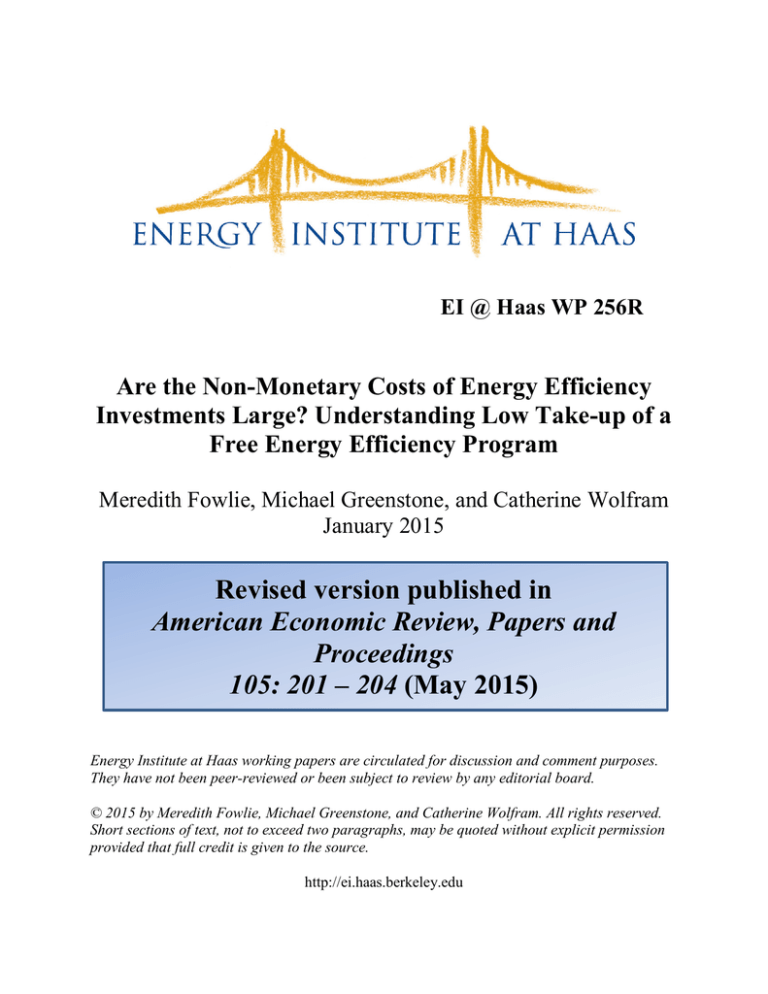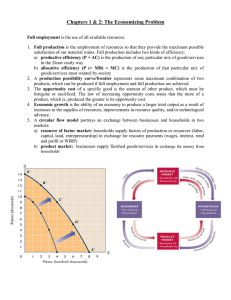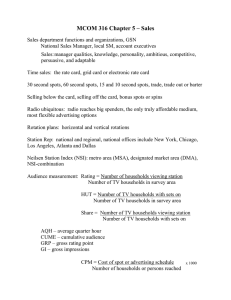
EI @ Haas WP 256R
Are the Non-Monetary Costs of Energy Efficiency
Investments Large? Understanding Low Take-up of a
Free Energy Efficiency Program
Meredith Fowlie, Michael Greenstone, and Catherine Wolfram
January 2015
Revised version published in
American Economic Review, Papers and
Proceedings
105: 201 – 204 (May 2015)
Energy Institute at Haas working papers are circulated for discussion and comment purposes.
They have not been peer-reviewed or been subject to review by any editorial board.
© 2015 by Meredith Fowlie, Michael Greenstone, and Catherine Wolfram. All rights reserved.
Short sections of text, not to exceed two paragraphs, may be quoted without explicit permission
provided that full credit is given to the source.
http://ei.haas.berkeley.edu
Are the Non-Monetary Costs of Energy Efficiency
Investments Large? Understanding Low Take-up of a
Free Energy Efficiency Program
by Meredith Fowlie, Michael Greenstone, and Catherine Wolfram
∗
January 2015
Abstract: We document very low take-up of an energy efficiency program that is widely
believed to be privately beneficial. Program participants receive a substantial home
“weatherization” retrofit; all installation and equipment costs are covered by the program.
Less than one percent of presumptively eligible households take up the program in the
control group. This rate increased only modestly after we took extraordinary efforts to
inform households - via multiple channels - about the sizeable benefits and zero monetary
costs. These findings are consistent with high non-monetary costs associated with program
participation and/or energy efficiency investments.
∗
Fowlie: UC Berkeley and NBER, fowlie@berkeley.edu. Greenstone: University of Chicago and NBER,
mgreenst@uchicago.edu. Wolfram: UC Berkeley and NBER, cwolfram@berkeley.edu. The authors gratefully
acknowledge financial support from the Alfred P. Sloan Foundation, the Rockefeller Foundation, the UC
Berkeley Energy and Climate Initiative, and institutional support from the Poverty Action Lab (JPAL), the
Center for Local, State, and Urban Policy (CLOSUP) at the University of Michigan, and the Energy Institute at
Haas. We thank James Gillan, Walter Graf, Erica Myers, Dan Stuart, Matthew Woerman, and Jesse Worker for
excellent research and project management assistance.
I.
Introduction
This paper finds striking evidence that individuals and households bypass opportunities to improve
energy efficiency that require zero out-of-pocket expenditures and are widely believed to be
privately beneficial. We report results from a large-scale randomized control trial that significantly
reduced barriers to participation in the Federal Weatherization Assistance Program (WAP). This
program, the largest residential energy efficiency program in the country, aims to reduce the
energy burden of low-income Americans by installing energy efficiency measures in their homes.
Since the program’s inception in 1976, more than 7 million households have received
weatherization assistance.
Related work (Fowlie et al., 2015) finds that participation in this program significantly reduces
energy consumption – and associated energy expenditures – among participating households. 1
These sizeable private benefits notwithstanding, a very small fraction of income-eligible families
apply for weatherization assistance. An even smaller fraction of eligible households actually receive
it. The low participation rates raise questions about what other factors – beyond monetary costs
and energy savings – drive adoption decisions.
The experiment was conducted with a sample of more than 30,000 households in Michigan who
were presumptively eligible for WAP. The treatment group was educated about WAP and offered
extensive personal assistance with completing the application. After a massive effort to reduce
barriers to participation, application rates and program participation remained low. Overall, the
evidence is consistent with high non-monetary costs associated with WAP participation and the
adoption of more involved energy efficiency improvements.
II. The Weatherization Assistance Program
The Weatherization Assistance Program provides free energy efficiency improvements to lowincome households. Federal support for this program increased significantly under the American
Reinvestment and Recovery Act (ARRA). Our study was conducted in Michigan during the ARRA-
funded period.
Our estimates of the net present value of energy savings (valued using retail energy prices) range from
$1500 to over $3,600, depending on assumptions about the lifespan of the investment and the relevant
discount rate. These savings appear to be substantially smaller than the costs of the energy efficiency
investments (Fowlie et al. 2015).
1
1
Participating households receive a free energy audit and a home retrofit that typically includes
some combination of insulation, window replacements, furnace replacement, and infiltration
reduction. The average value of the efficiency retrofits provided to participating households in our
study exceeds $5000 per home.
Although households incur no direct monetary costs to participate, the process of applying for
weatherization is onerous and time intensive, at least partially to prevent fraud. Applicants must
submit extensive paperwork documenting their eligibility, including utility bills, earnings
documentation, social security numbers and deeds to the home. Eligible applicants are then
prioritized following guidelines that recommend ranking applicants highly if the household
includes elderly, persons with disabilities or families with children, or where the occupants
typically face a high energy burden (energy as a share of income) or have high residential energy
use (see 10 CFR 440.16(b) (1-5)).
III. Research Design
The study was conducted on a sample of over 30,000 presumptively eligible households in the
state of Michigan. Approximately one quarter of these were randomly assigned to an
encouragement “treatment.” The remaining “control” households were free to apply for WAP but
were not contacted or assisted in any way by our team. 2
We worked closely with a well-respected organization that specializes in designing
communications strategies and managing outreach campaigns to develop a persuasive recruit and
assist strategy. The encouragement phase of our efforts began in March 2011. Our field staff, many
of whom were trusted individuals hired from the communities where the experiment was
conducted, made almost 7,000 initial, in-person house visits. These ground operations were
complemented with 23,500 targeted “robo-calls" and over 15,000 door hangers and mailed post
cards to raise awareness of both the weatherization program and our encouragement campaign.
When this information campaign was complete, all households in the encouraged group had
received some form of communication, with most contacted several times. Our team was able to
speak in person with almost two thirds of the treated households (the remaining households could
not be found at home during canvas operations or did not answer the door).
2
See Fowlie et al. (2015) for further details on the experimental design.
2
Following this initial encouragement phase, the field operations transitioned to an enrollment
phase. Over the course of approximately 9,000 personal phone calls and 2,700 home visits, the staff
helped individuals complete and deliver paperwork to the implementing agencies. the
encouragement and enrollment efforts cost approximately $450,000, which amounts to $50 per
targeted household and over $1000 per weatherized household. 3
IV. Empirical findings
Figure 1 provides a graphical summary of how our randomized encouragement intervention
affected program participation. The figure highlights the low levels of participation in both the
control and treatment groups. Even after the extensive efforts to encourage participation, only 15
percent of the households in the treated group, less than one-quarter of those to whom our team
spoke, submitted an application and fewer than 6 percent of them actually received a
weatherization.
However, the intervention had a significant impact on both the application and weatherization
rates of the treatment group, relative to the control group. In the control group, only 2 percent of
the households applied to the program compared to 15 percent in the encouraged group. The rate
at which households received a weatherization retrofit increased from less than 1 percent in the
control group to almost 6 percent in our encouraged group. Notably, the weatherization rate
conditional on submitting an application does not vary significantly across the control and
treatment groups.
Our intervention eliminated some – but by no means all – of the time and effort required to
participate in the program. Households in the treatment group had to actively decide to participate,
engage with our staff, meet with contractors, endure the hassle of having a construction team
working in their home, etc. One interpretation of our findings is that these remaining costs
exceeded the expected benefits from weatherization for a majority of households.
We cannot identify the specific households that participated in the program due to our
encouragement intervention. However, a comparison of observable characteristics across
households that received a weatherization retrofit in the control group and households receiving a
To put these numbers into perspective, the cost per weatherized household is lower than customer
acquisition costs reported by solar providers who are similarly offering households the opportunity to lower
future energy expenditures (although targeting households in a different demographic and requiring an
upfront investment) (see Seel et al., 2014).
3
3
retrofit in the encouraged group reveals what types of households were moved to participate by
our encouragement.
Table 1 makes this comparison using data on household demographics, energy consumption,
housing characteristics and projected savings. The demographics and housing characteristics are
collected by the local community action agency, which is responsible for screening applicants and
implementing the home retrofits. These implementing agencies also conduct an energy audit at
each home that files an eligible WAP application before it is weatherized to determine which
measures are projected to reduce expected energy expenditures by more than their costs. We
collected energy consumption data from the local utility. See Fowlie et al. (2015) for more details.
The first two columns report the average values and standard deviations (in parentheses) for the
control and encouraged participants, respectively. The third column reports the difference in group
means. These summary statistics show that a reduction in the information and process costs borne
by the households results in a significant increase in the income level of program participants.
Encouraged participants are also larger on average, more likely to have children in the home, and
more likely to report an elderly resident as compared to weatherized households in the control
group. Although the floor area of weatherized homes does not vary across groups, homes are
somewhat newer in the encouraged group. Households in the encouraged group had slightly lower
levels of winter gas consumption and slightly higher levels of electricity consumption historically.
Efficiency audits conducted at all participating households prior to weatherization projected
relatively lower savings, lower weatherization costs, and lower projected savings to investment
ratios among encouraged participants.
This heterogeneity in households’ response to a reduction in process and information costs has
implications for program targeting. A growing literature explores the extent to which “ordeal
mechanisms" result in improved targeting of program resources (Alatas et al., 2012). By contrast,
Allcott, et al. (2015) document that energy efficiency programs that are not means tested are likely
taken up by households who are less likely to experience market failures, such as poor information.
In this setting, onerous application procedures could be advantageous if they serve to discourage
households with less to gain from a weatherization retrofit Along some dimensions, the results are
consistent with this interpretation as we observe households with higher projected net savings and
lower incomes in the control group of participants. However, groups targeted by the WAP program
4
include the elderly, disabled, households with children. Among these groups, we find a reduction in
process costs can increase participation.
V. Discussion
There is a large and persistent difference between the levels of investment in energy efficiency that
appear to be privately beneficial and the investments that private individuals actually pursue
(Allcott and Greenstone, 2012). The economics literature has identified several possible
explanations for this apparent gap. This study sheds light on the role that information and
transaction costs can play in determining household-level decisions to pursue residential energy
efficiency improvements.
This study documents that households take-up an energy efficiency retrofit with zero out of pocket
costs and roughly $5,000 of improvements to their homes at a very low rate. Further, the take-up is
only modestly increased by extraordinary efforts to inform households - via multiple channels -
about the sizeable benefits and zero monetary costs. These findings are consistent with high non-
monetary costs associated with WAP participation and/or energy efficiency investments, at least
for the population we studied. High non-monetary costs associated with these investments would
suggest the energy efficiency gap in the residential sector is narrower than it appears.
5
References
Alatas, Vivi, Abhijit Banerjee, Rema Hanna, Benjamin A. Olken, and Julia Tobias. 2012.
"Targeting the Poor: Evidence from a Field Experiment in Indonesia." American Economic
Review 102(4): 1206-40.
Allcott, Hunt and Michael Greenstone. 2012 “Is There an Energy Efficiency Gap?” Journal of
Economic Perspectives 26(1): 3-28.
Allcott, Hunt, Chris Knittel and Dmitry Taubinsky. 2015. “Tagging and Targeting of Energy
Efficiency Subsidies.” American Economic Review Papers and Proceedings, this volume.
Fowlie, Meredith, Michael Greenstone, and Catherine Wolfram. 2015. “Do Energy Efficiency
Investments Deliver? Evidence from the Weatherization Assistance Program.” The E2e
Project Working Paper.
Seel, Joachim, Galen L. Barbose and Ryan Wiser. 2014. “An Analysis of Residential PV
System Price Differences between the United States and Germany.” Energy Policy 69 (June):
216-226.
6
0.7
Success rate
0.6
0.5
0.4
0.3
0.2
0.1
0
Personal Contact
Rate
Control group
Application rate
Weatherization rate
Encouraged group
Figure 1: Application and weatherization rates across groups
Notes: This figure summarizes the rate at which households were contacted in person by
our team, submitted a complete application, and successfully received weatherization
assistance. Note that the personal contact rate includes home visits only. A much larger
fraction of the treatment group was reached via telephone and/or mail.
7
Table 1: Differences in sample means between groups of weatherized households
Experimental
control
(1)
Experimental
encouraged
(2)
(2) - (1)
17,048
( 8,840)
19,783
(12,172)
2,735∗∗
( 1,016)
Household size (# people)
1.99
(1.30)
2.37
(1.60)
0.38∗∗
(0.14)
Children (share of hh)
0.19
(0.40)
0.27
(0.44)
0.07∗
(0.04)
Elderly (share of hh)
0.28
(0.45)
0.38
(0.49)
0.11∗∗
(0.04)
Reported disability (share of hh)
0.04
(0.21)
0.04
(0.19)
-0.01
(0.02)
(3)
Household demographics
Household income ($)
Monthly energy consumption, dwelling characteristics
Winter gas (MMBtu)
10.42
(3.93)
9.80
(3.47)
-0.62∗
(0.32)
Electricity (MMBtu)
2.02
(0.95)
2.21
(1.07)
0.19∗∗
(0.09)
Age of home(yrs)
62.87
(18.80)
58.92
(20.73)
-3.94∗∗
(1.94)
Floor area (sq. ft.)
1759.62
(596.33)
1733.61
(594.10)
-26.01
(57.33)
5287.18
(2912.26)
4620.07
(2619.31)
-667.11∗∗
(283.75)
Proj. savings (MMBtu)
63.71
(44.11)
55.36
(41.83)
-8.35∗∗
(4.10)
Projected savings:investment ratio
2.07
(1.28)
1.81
(1.04)
-0.26∗∗
(0.11)
178
435
Retrofit costs and projected savings
Reported cost (total)
Households
Note: Columns numbered (1) and (2) report average values and standard deviations(in
parentheses). Column three reports differences in means (standard errors are in parentheses).
* Significant at the 10 percent level
** Significant at the 5 percent level
8





